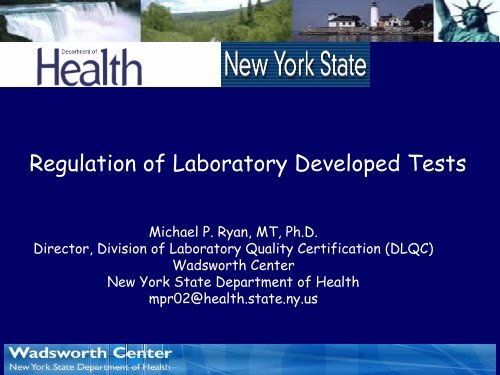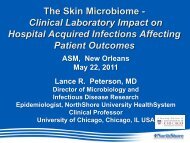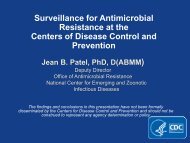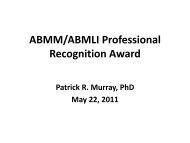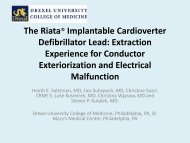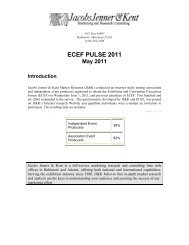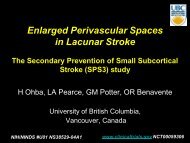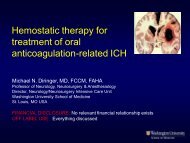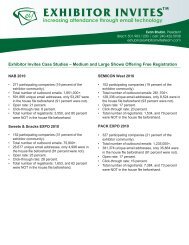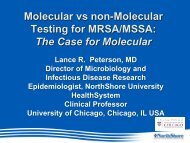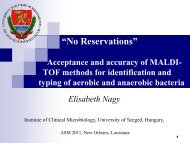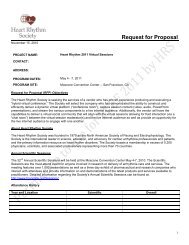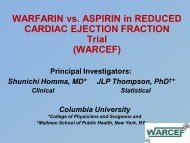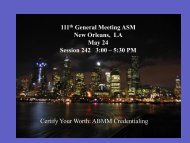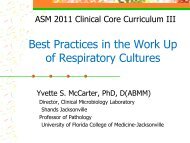Regulation of Laboratory Developed Tests
Regulation of Laboratory Developed Tests
Regulation of Laboratory Developed Tests
You also want an ePaper? Increase the reach of your titles
YUMPU automatically turns print PDFs into web optimized ePapers that Google loves.
<strong>Regulation</strong> <strong>of</strong> <strong>Laboratory</strong> <strong>Developed</strong> <strong>Tests</strong><br />
Michael P. Ryan, MT, Ph.D.<br />
Director, Division <strong>of</strong> <strong>Laboratory</strong> Quality Certification (DLQC)<br />
Wadsworth Center<br />
New York State Department <strong>of</strong> Health<br />
mpr02@health.state.ny.us
Wadsworth Center<br />
Division <strong>of</strong> <strong>Laboratory</strong> Quality Certification<br />
(DLQC)<br />
DLQC Programs<br />
•Environmental <strong>Laboratory</strong> Approval Program (ELAP)<br />
•Blood and Tissue Resources Program (BTRP)<br />
•Physicians Office <strong>Laboratory</strong> Evaluation Program (POLEP)<br />
•Regulatory Affairs/<strong>Laboratory</strong> Investigative Unit (RA/LIU)<br />
•Breath Alcohol Permit Program (BAPP)<br />
•Regulated Medical Waste Program (RMW)<br />
•Clinical <strong>Laboratory</strong> Evaluation Program (CLEP)
Wadsworth Center<br />
Clinical <strong>Laboratory</strong> Reference System<br />
• Division <strong>of</strong> Environmental Health Sciences<br />
• Division <strong>of</strong> Genetics<br />
• Division <strong>of</strong> Infectious Disease<br />
• Division <strong>of</strong> Translational Medicine<br />
• Division <strong>of</strong> <strong>Laboratory</strong> Quality Certification
Clinical <strong>Laboratory</strong> Reference System<br />
The Department <strong>of</strong> Health's Wadsworth Center is charged with<br />
oversight <strong>of</strong> clinical laboratories and blood banks operating in New York<br />
State.<br />
This oversight is carried out through the Clinical <strong>Laboratory</strong> Reference<br />
System.<br />
Reference system activities include:<br />
•on-site surveys <strong>of</strong> facilities<br />
•pr<strong>of</strong>iciency testing <strong>of</strong> laboratories<br />
•review <strong>of</strong> laboratory personnel<br />
•reviewing and approving laboratory-developed assays
Part 58-1.10(g) <strong>of</strong> 10 NYCRR<br />
Assay Approval<br />
All technical procedures employed in a laboratory shall be <strong>of</strong><br />
proven reliability and generally accepted by leading<br />
authorities in the specialty <strong>of</strong> laboratory medicine and/or<br />
approved by the department.
Assay Approval<br />
We review assays in all disciplines <strong>of</strong> laboratory medicine<br />
including:<br />
Bacteriology<br />
Cellular immunology<br />
Clinical chemistry<br />
Cytogenetics<br />
Cytopathology<br />
Diagnostic immunology<br />
Endocrinology<br />
Fetal defect markers<br />
Forensic identity<br />
Genetics<br />
Hematology<br />
Histocompatibility<br />
HIV<br />
Immunohematology<br />
Mycobacteriology<br />
Mycology, oncology<br />
Parasitology<br />
Therapeutic substance monitoring<br />
Toxicology<br />
Virology
Assay Approval<br />
In the past 10 years, over 5,000 packages have been<br />
submitted for review.<br />
In 2009, approximately 40% <strong>of</strong> the 950 laboratories that<br />
we regulate submitted packages for review.
Scope <strong>of</strong> Reviews<br />
What type <strong>of</strong> assays require review and approval?<br />
Assays not expressly approved (PMA), cleared (510k), or<br />
exempted by the FDA, including:<br />
•Commercialized test kits variously labeled as Research<br />
Use Only (RUO) or Investigational Use Only (IUO)<br />
•<strong>Laboratory</strong> <strong>Developed</strong> <strong>Tests</strong> (LDTs) that include the use<br />
<strong>of</strong> reagents prepared by the lab and/or analyte-specific<br />
reagents (ASRs)<br />
•FDA cleared/approved tests that have been modified<br />
from their intended use
Scope <strong>of</strong> Reviews<br />
Comprehensive Test Approval Policy and Guidelines<br />
Description <strong>of</strong> Assays/<strong>Tests</strong><br />
Instructions on how to apply<br />
General Requirements for Assay Validation<br />
Guidance documents for specific scientific disciplines<br />
•Cellular Immunology<br />
•Forensic Identity<br />
•Genetic Testing-Molecular<br />
•Molecular Microbiology<br />
•Oncology-Molecular<br />
•Toxicology<br />
•Trace Elements<br />
•Cytogenetics under development<br />
(http://www.wadsworth.org/labcert/TestApproval/forms/Submission_Guidelines_Policy.pdf)
Scope <strong>of</strong> Reviews<br />
Molecular Microbiology-nucleic acid amplification assays<br />
http://www.wadsworth.org/labcert/TestApproval/forms/M<br />
icrobiology_NAAT_Checklist.pdf
Scope <strong>of</strong> Reviews<br />
Molecular Microbiology-nucleic acid amplification assays<br />
Information Reviewed:<br />
•standard operating procedure manual (SOPM)<br />
•test requisitions and reports<br />
•pertinent literature references<br />
•summary <strong>of</strong> validation studies and supporting data<br />
•plans for carrying out pr<strong>of</strong>iciency testing
Scope <strong>of</strong> Reviews<br />
Molecular Microbiology-nucleic acid amplification assays<br />
Standard Operating Procedure Manual<br />
Overview <strong>of</strong> the Assay<br />
• an overview describing the scientific basis <strong>of</strong> the test and<br />
an explanation <strong>of</strong> the assay<br />
• target gene or region being amplified with the location <strong>of</strong><br />
primers and probes<br />
• oligonucleotide list with sequences<br />
• target population <strong>of</strong> the assay and clinical validity
Scope <strong>of</strong> Reviews<br />
Molecular Microbiology-nucleic acid amplification assays<br />
Standard Operating Procedure Manual<br />
Procedure:<br />
• detailed step-by-step protocol<br />
•specimen collection, processing, storage, rejection criteria<br />
•sources <strong>of</strong> reagents and equipment<br />
•description <strong>of</strong> controls<br />
•interpretation <strong>of</strong> results<br />
•technical limitations <strong>of</strong> the assay<br />
•steps taken to minimize amplicon contamination
Scope <strong>of</strong> Reviews<br />
Molecular Microbiology-nucleic acid amplification assays<br />
Standard Operating Procedure Manual<br />
Guidance on use and preparation <strong>of</strong> controls<br />
Description <strong>of</strong> the types <strong>of</strong> controls that need to be included:<br />
•positive lysis/extraction control<br />
•negative lysis/extraction control<br />
•inhibition control<br />
•reagent contamination control
Scope <strong>of</strong> Reviews<br />
Molecular Microbiology-nucleic acid amplification assays<br />
Method Validation<br />
Data needs to be submitted that demonstrates the<br />
analytical and clinical validity <strong>of</strong> the assay.<br />
•Analytical validity means the ability <strong>of</strong> the assay to meet<br />
technical performance specifications<br />
•Clinical validity means the proven ability <strong>of</strong> an assay to<br />
reliably identify a specific condition in a test subject.
Scope <strong>of</strong> Reviews<br />
Molecular Microbiology-nucleic acid amplification assays<br />
Method Validation<br />
Summary <strong>of</strong> validation studies and results<br />
Data:<br />
•specificity<br />
•sensitivity (limit <strong>of</strong> detection)<br />
•reproducibility (inter- and intra-assay reproducibility)<br />
•accuracy verification<br />
Guidance is provided describing approaches that can be<br />
used to carry out these studies.
Scope <strong>of</strong> Reviews<br />
Molecular Microbiology-nucleic acid amplification assays<br />
Method Validation<br />
Specificity<br />
Must determine that assay does not detect related organisms,<br />
organisms producing similar illness, or organisms that may be present in<br />
specimen types to be tested.<br />
S. aureus Enterotoxin Type B<br />
Tested 69 different organisms including:<br />
• Organisms causing similar enteric illness<br />
• Genetic near neighbors<br />
• Other toxin producing S. aureus and Clostridium sp.<br />
• Select Agents<br />
* If cross-specificity is found, must be included on the patient report
Scope <strong>of</strong> Reviews<br />
Molecular Microbiology-nucleic acid amplification assays<br />
Method Validation<br />
Sensitivity (limit <strong>of</strong> detection)<br />
Data from a dilution series <strong>of</strong> a known concentration <strong>of</strong> the target<br />
(preferably whole organism) that is spiked into negative clinical samples<br />
for each matrix being validated.<br />
Perform 3 separate extractions <strong>of</strong> this dilution series and test in<br />
duplicate.<br />
The dilution series must encompass six dilutions including one below the<br />
limit <strong>of</strong> detection <strong>of</strong> the assay.<br />
If the LOD is determined to be >100 gene copies, linearity data must<br />
be provided.
Inter-assay reproducibility<br />
Scope <strong>of</strong> Reviews<br />
Molecular Microbiology-nucleic acid amplification assays<br />
Method Validation<br />
At least 3 authentic clinical samples or spiked clinical samples<br />
should be run on three different days.<br />
If spiked, the three samples should include one concentration at<br />
or near the limit <strong>of</strong> detection.<br />
Alternatively, a single positive control run repeatedly over many<br />
days (15 or more) may be used.
Intra-assay reproducibility<br />
Scope <strong>of</strong> Reviews<br />
Molecular Microbiology-nucleic acid amplification assays<br />
Method Validation<br />
At least 3 authentic clinical samples or spiked clinical samples<br />
should be run in triplicate.<br />
If spiked, the three samples should include at least one<br />
concentration at or near the limit <strong>of</strong> detection.<br />
Also, if different instruments, platforms, models or technicians<br />
will be used to perform the assay, demonstrate the assay’s<br />
consistency across these variables.
Assay Verification<br />
Scope <strong>of</strong> Reviews<br />
Molecular Microbiology-nucleic acid amplification assays<br />
Method Validation<br />
Accuracy should be verified by conducting a randomized, blinded validation<br />
study where the assay results are compared to those <strong>of</strong> a gold standard or<br />
FDA or CLEP approved assay.<br />
Provide data from at least 30 positive samples and 10 negative samples. The<br />
samples should be authentic clinical specimens, but spiked samples are<br />
acceptable when clinical specimens are not available.<br />
If spiked samples are used, at least 10 samples should be close to the LOD<br />
(maximum, 10-fold above that level).<br />
If authentic clinical samples are used, at least 10 <strong>of</strong> the 30 positives should<br />
be weak positives, if the methods used allow for this determination. Include<br />
multiple different strains and specimens.
Scope <strong>of</strong> Reviews<br />
Molecular Microbiology-nucleic acid amplification assays<br />
Method Validation<br />
Assay Verification (cont.)<br />
For quantitative assays, provide data across the full range <strong>of</strong><br />
concentrations likely to be encountered in clinical samples.<br />
Multiplex assays (especially those with multiple sample types) can<br />
present a difficult situation for the design <strong>of</strong> a validation study,<br />
since it can be a large and expensive endeavor to assay 40 samples<br />
(30positive and 10 negative) for each analyte in each specimen type.<br />
Samples can be spiked with multiple organisms, so as to reduce the<br />
number <strong>of</strong> samples required. We may be contacted for guidance<br />
prior to the submission <strong>of</strong> a package with multiplex analysis having<br />
four or more simultaneous targets.
Scope <strong>of</strong> Reviews<br />
Molecular Microbiology-nucleic acid amplification assays<br />
Method Validation<br />
Additional Guidance Provided<br />
•Broad range sequencing to identify bacteria, mycobacteria, or fungi<br />
•Subtyping using nucleic acid sequencing and comparisons to sequence<br />
databases<br />
•Prognostic viral typing assays
Acknowledgements<br />
Division <strong>of</strong> Infectious Diseases<br />
•Ron Limberger<br />
•Christina Egan<br />
•Kim Musser<br />
Clinical <strong>Laboratory</strong> Evaluation Program<br />
•Stephanie Shulman<br />
•Michael Neal<br />
Division <strong>of</strong> <strong>Laboratory</strong> Quality Certification<br />
•Kathleen Davis


